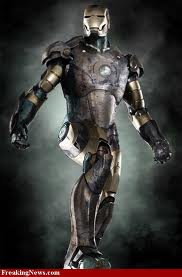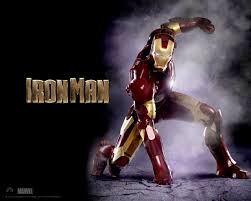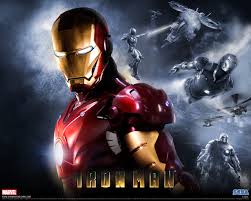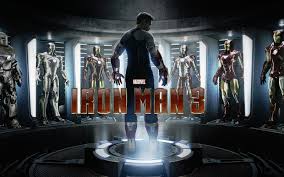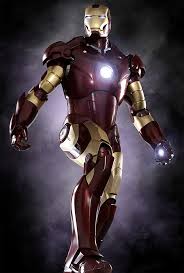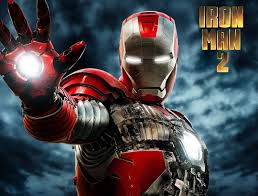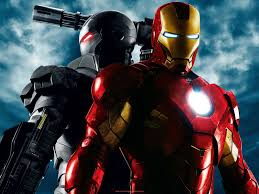Iron Man
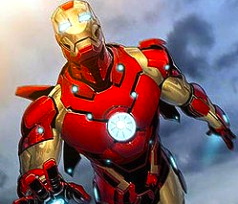
Iron man 3, 2, 1 Full Movie Armor Upclose HD!
 Promotional art for The Invincible Iron Man vol. 5, #25 (second printing) (June 2010) by Salvador Larroca.
Promotional art for The Invincible Iron Man vol. 5, #25 (second printing) (June 2010) by Salvador Larroca.
Iron Man is a fictional character, a superhero who appears in comic books published by Marvel Comics. The character was created by writer-editor Stan Lee, developed by scripter Larry Lieber, and designed by artists Don Heck and Jack Kirby. He made his first appearance in Tales of Suspense #39 (March 1963).
An American billionaire playboy, industrialist and ingenious engineer, Tony Stark suffers a severe chest injury during a kidnapping in which his captors attempt to force him to build a weapon of mass destruction. He instead creates a powered suit of armor to save his life and escape captivity. He later uses the suit and successive versions to protect the world as Iron Man. Through his corporation ―Stark Industries ― Tony has created many military weapons, some of which, along with other technological devices of his making, have been integrated into his suit, helping him fight crime. Initially, Iron Man was a vehicle for Stan Lee to explore Cold War themes, particularly the role of American technology and business in the fight against communism. Subsequent re-imaginings of Iron Man have transitioned from Cold War themes to contemporary concerns, such as corporate crime and terrorism.
Throughout most of the character’s publication history, Iron Man has been a member of the superhero team the Avengers and has been featured in several incarnations of his own various comic book series. Iron Man has been adapted for several animated TV shows and films. The character is portrayed by Robert Downey, Jr. in the live action film Iron Man (2008), which was a critical and box office success. Downey, who received much acclaim for his performance, reprised the role in several Marvel Cinematic Universe films, including two Iron Man sequels and The Avengers (2012). Iron Man was ranked 12th on IGN’s Top 100 Comic Book Heroes in 2011.
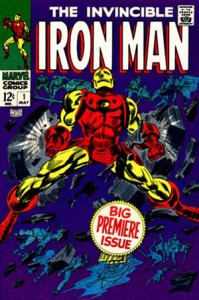 Publication history – Premiere
Publication history – Premiere
Iron Man’s Marvel Comics premiere in Tales of Suspense #39 was a collaboration among editor and story-plotter Stan Lee, scripter Larry Lieber, story-artist Don Heck, and cover-artist and character-designer Jack Kirby. In 1963, Lee had been toying with the idea of a businessman superhero. He wanted to create the “quintessential capitalist”, a character that would go against the spirit of the times and Marvel’s readership. Lee said,
“I think I gave myself a dare. It was the height of the Cold War. The readers, the young readers, if there was one thing they hated, it was war, it was the military….So I got a hero who represented that to the hundredth degree. He was a weapons manufacturer, he was providing weapons for the Army, he was rich, he was an industrialist….I thought it would be fun to take the kind of character that nobody would like, none of our readers would like, and shove him down their throats and make them like him….And he became very popular.”
He set out to make the new character a wealthy, glamorous ladies’ man, but one with a secret that would plague and torment him as well. Writer Gerry Conway said, “Here you have this character, who on the outside is invulnerable, I mean, just can’t be touched, but inside is a wounded figure. Stan made it very much an in-your-face wound, you know, his heart was broken, you know, literally broken. But there’s a metaphor going on there. And that’s, I think, what made that character interesting.” Lee based this playboy’s looks and personality on Howard Hughes, explaining, “Howard Hughes was one of the most colorful men of our time. He was an inventor, an adventurer, a multi-billionaire, a ladies’ man and finally a nutcase.” “Without being crazy, he was Howard Hughes,” Lee said.
While Lee intended to write the story himself, a minor deadline emergency eventually forced him to hand over the premiere issue to Lieber, who fleshed out the story. The art was split between Kirby and Heck. “He designed the costume,” Heck said of Kirby, “because he was doing the cover. The covers were always done first. But I created the look of the characters, like Tony Stark and his secretary Pepper Potts.” Iron Man first appeared in 13- to 18-page stories inTales of Suspense, which featured anthology science fiction and supernatural stories. The character’s original costume was a bulky gray armored suit, replaced by a golden version in the second story (issue #40, April 1963). It was redesigned as sleeker, red-and-golden armor in issue #48 (Dec. 1963) by that issue’s interior artist, Steve Ditko, although Kirby drew it on the cover. As Heck recalled in 1985, “[T]he second costume, the red and yellow one, was designed by Steve Ditko. I found it easier than drawing that bulky old thing. The earlier design, the robot-looking one, was more Kirbyish.
In his premiere, Iron Man was an anti-communist hero, defeating various Vietnamese agents. Lee later regretted this early focus. Throughout the character’s comic book series, technological advancement and national defense were constant themes for Iron Man, but later issues developed Stark into a more complex and vulnerable character as they depicted his battle with alcoholism (as in the “Demon in a Bottle” storyline) and other personal difficulties.
 From issue #59 (Nov. 1964) to its final issue #99 (March 1968), the anthological science-fiction backup stories in Tales of Suspense were replaced by a feature starring the superhero Captain America. Lee and Heck introduced several adversaries for the character including the Mandarin in issue #50 (Feb. 1964), the Black Widow in #52 (April 1964) and Hawkeye five issues later.
From issue #59 (Nov. 1964) to its final issue #99 (March 1968), the anthological science-fiction backup stories in Tales of Suspense were replaced by a feature starring the superhero Captain America. Lee and Heck introduced several adversaries for the character including the Mandarin in issue #50 (Feb. 1964), the Black Widow in #52 (April 1964) and Hawkeye five issues later.
Lee said that “of all the comic books we published at Marvel, we got more fan mail for Iron Man from women, from females, than any other title….We didn’t get much fan mail from girls, but whenever we did, the letter was usually addressed to Iron Man.”
Lee and Kirby included Iron Man in The Avengers #1 (Sept. 1963) as a founding member of the superhero team. The character has since appeared in every subsequent volume of the series.
Writers have updated the war and locale in which Stark is injured. In the original 1963 story, it was the Vietnam War. In the 1990’s, it was updated to be the first Gulf War, and later updated again to be the war in Afghanistan. Stark’s time with the Asian Nobel Prize-winning scientist Ho Yinsen is consistent through nearly all incarnations of the Iron Man origin, depicting Stark and Yinsen building the original armor together. One exception is the direct-to-DVD animated feature film The Invincible Iron Man, in which the armor Stark uses to escape his captors is not the first Iron Man suit.
The original Iron Man title explored Cold War themes, as did other Stan Lee projects in the early years of Marvel Comics. Where The Fantastic Four and The Incredible Hulk respectively focused on American domestic and government responses to the Communist threat, Iron Man explored industry’s role in the struggle. Tony Stark’s real-life model, Howard Hughes, was a significant defense contractor who developed new weapons technologies. Hughes was an icon both of American individualism and of the burdens of fame.
Historian Robert Genter, in The Journal of Popular Culture, writes that Tony Stark specifically presents an idealized portrait of the American inventor. Where earlier decades had seen important technological innovations come from famous individuals like Nikola Tesla, Thomas Edison, Alexander Graham Bell and the Wright brothers, the 1960’s saw new technology, including weapons, being developed mainly by corporate research teams. Little room remained in this environment for the inventor who wanted credit for, and control of, his or her own creations.
Issues of entrepreneurial autonomy, government supervision of research, and ultimate loyalty figured prominently in early Iron Manstories—and all were issues then affecting American scientists and engineers. Tony Stark, writes Genter, is an inventor who finds motive in his emasculation as an autonomous creative individual. This blow is symbolized by his chest wound, inflicted at the moment he is forced to invent things for the purposes of others. Stark’s transformation into Iron Man represents his effort to reclaim his autonomy, and thus his manhood. The character’s pursuit of women in bed or in battle, writes Genter, represents another aspect of this effort. The pattern finds parallels in other works of 1960’s popular fiction by authors such as “Ian Fleming, Mickey Spillane, and Norman Mailer who made unregulated sexuality a form of authenticity.”
After issue #99 (March 1968), the Tales of Suspense series was renamed Captain America. An Iron Man story appeared in the one-shot comic Iron Man and Sub-Mariner (April 1968), before the “Golden Avenger” made his solo debut with The Invincible Iron Man #1 (May 1968). The series’ indicia gives its copyright title Iron Man, while the trademarked cover logo of most issues is The Invincible Iron Man. Artist George Tuska began a decade long association with the character with Iron Man #5 (Sept. 1968). Writer Mike Friedrich and artist Jim Starlin‘s brief collaboration on the Iron Man series introduced Mentor, Starfox, and Thanos in issue #55 (Feb. 1973). Friedrich scripted a metafictional story in which Iron Man visited the San Diego Comic Convention and met several Marvel Comics writers and artists. He then wrote the multi-issue “War of the Super-Villains” storyline which ran through 1975.
Writer David Michelinie, co-plotter/inker Bob Layton, and penciler John Romita, Jr. became the creative team on the series withIron Man #116 (Nov. 1978). Micheline and Layton established Tony Stark’s alcoholism with the story “Demon in a Bottle“, and introduced several supporting characters, including Stark’s bodyguard girlfriend Bethany Cabe; Stark’s personal pilot and confidant James Rhodes, who later became the superhero War Machine; and rival industrialist Justin Hammer, who was revealed to be the employer of numerous high-tech armed enemies Iron Man fought over the years. The duo also introduced the concept of Stark’s specialized armors as he acquired a dangerous vendetta with Doctor Doom. The team worked together through #154 (Jan. 1982), with Michelinie writing three issues without Layton.
Following Michelinie and Layton’s departures, Dennis O’Neil became the new writer of the series and had Stark relapse into alcoholism. Jim Rhodes replaced Stark as Iron Man in issue #169 (April 1983) and wore the armor for the next two years of stories. O’Neil returned Tony Stark to the Iron Man role in issue #200 (Nov. 1985). Michelinie and Layton became the creative team once again in issue #215 (Feb. 1987). They crafted the “Armor Wars” storyline beginning in #225 (Dec. 1987) through #231 (June 1988). John Byrne and John Romita, Jr. produced a sequel titled “Armor Wars II” in issues #258 (July 1990) to #266 (March 1991). The series had a crossover with the other Avengers related titles as part of the “Operation: Galactic Storm” storyline.
This initial series ended with issue #332 (Sept. 1996). A second volume, written primarily by differing teams of the trio Jim Lee, Scott Lobdell, and Jeph Loeb, and drawn primarily by Whilce Portacio and Ryan Benjamin successively, took place in a parallel universe and ran 13 issues (Nov. 1996 – Nov. 1997). Volume 3, whose first 25 issues were written by Kurt Busiek initially and then by Busiek and Roger Stern, ran 89 issues (Feb. 1998 – Dec. 2004). Later writers included Joe Quesada, Frank Tieri, Mike Grell, and John Jackson Miller. Issue #41 (June 2001) was additionally numbered #386, reflecting the start of dual numbering starting from the premiere issue of volume one in 1968. The final issue was dual-numbered as #434. The next Iron Man series,The Invincible Iron Man vol. 4, debuted in early 2005 with the Warren Ellis-written storyline “Extremis,” with artist Adi Granov. It ran 35 issues (Jan. 2005 – Jan. 2009), with the cover logo simply Iron Man beginning with issue #13, and Iron Man: Director of S.H.I.E.L.D., beginning issue #15. On the final three issues, the cover logo was overwritten by “War Machine, Weapon of S.H.I.E.L.D.,” which led to the launch of a War Machine ongoing series.
The Invincible Iron Man vol. 5, by writer Matt Fraction and artist Salvador Larroca, began with a premiere issue cover-dated July 2008. For a seven-month overlap, Marvel published both volume four and volume five simultaneously. Volume five jumped its numbering of issues from #33 to #500, cover dated March 2011, to reflect the start from the premiere issue of volume one in 1968.
Many Iron Man annuals, miniseries, and one-shot titles have been published through the years, such as Age of Innocence: The Rebirth of Iron Man (Feb. 1996), Iron Man: The Iron Age #1-2 (Aug.-Sept. 1998), Iron Man: Bad Blood #1-4 (Sept.-Dec. 2000), Iron Man House of M #1-3 (Sept.-Nov. 2005), Fantastic Four / Iron Man: Big in Japan #1-4 (Dec. 2005 – March 2006), Iron Man: The Inevitable #1-6 (Feb.-July 2006), Iron Man / Captain America: Casualties of War (Feb. 2007), Iron Man: Hypervelocity #1-6 (March-Aug. 2007), Iron Man: Enter the Mandarin #1-6 (Nov. 2007 – April 2008), and Iron Man: Legacy of Doom (June-Sept. 2008). Publications have included such spin-offs as the one-shot Iron Man 2020 (June 1994), featuring a different Iron Man in the future, and the animated TV series adaptations Marvel Action Hour, Featuring Iron Man #1-8 (Nov. 1994 – June 1995) and Marvel Adventures Iron Man #1-12 (July 2007 – June 2008).
Fictional character biography
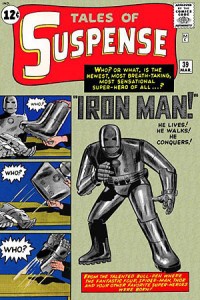 Tales of Suspense #39 (March 1963): Iron Man debuts. Cover art by Jack Kirby and Don Heck.
Tales of Suspense #39 (March 1963): Iron Man debuts. Cover art by Jack Kirby and Don Heck.
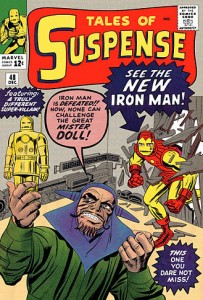 Tales of Suspense #48 (Dec. 1963), the debut of Iron Man’s first red-and-gold suit of armor. Cover art by Jack Kirby and Sol Brodsky.
Tales of Suspense #48 (Dec. 1963), the debut of Iron Man’s first red-and-gold suit of armor. Cover art by Jack Kirby and Sol Brodsky.
Origins
Anthony Edward Stark, the son of wealthy industrialist and head of Stark Industries, Howard Stark, and Maria Stark, is born on Long Island. A boy genius, he enters MIT at the age of 15 to study electrical engineering and later receives Master’s degrees in electrical engineering and physics. After his parents are killed in a plane accident, he inherits his father’s company.
Tony Stark is injured by a booby trap and captured by the enemy led by Wong-Chu, who then orders him to design weapons. Stark’s injuries are dire and shrapnel is moving towards his heart. His fellow prisoner, Ho Yinsen, a Nobel Prize-winning physicist whose work Stark had greatly admired during college, constructs a magnetic chest plate to keep the shrapnel from reaching Stark’s heart, keeping him alive. In secret, Stark and Yinsen use the workshop to design and construct a suit of powered armor, which Stark uses to escape. But during the escape attempt, Yinsen sacrifices his life to save Stark’s by distracting the enemy as Stark recharges. Stark takes revenge on his kidnappers and heads back to rejoin the American forces, on his way meeting a wounded American Marine fighter pilot, James “Rhodey” Rhodes.
Back home, Stark discovers that the shrapnel fragment lodged in his chest cannot be removed without killing him, and he is forced to wear the armor’s chestplate beneath his clothes to act as a regulator for his heart. He must recharge the chestplate every day or else risk the shrapnel killing him. The cover for Iron Man is that he is Stark’s bodyguard and corporate mascot. To that end, Iron Man fights threats to his company, such as Communist opponents Black Widow, the Crimson Dynamo and the Titanium Man, as well as independent villains like the Mandarin, who eventually becomes his greatest enemy. No one suspects Stark of being Iron Man as he cultivates an image as a rich playboy and industrialist. Two notable members of Stark’s supporting cast at this point are his personal chauffeur Harold “Happy” Hogan and secretary Virginia “Pepper” Potts, to both of whom he eventually reveals his dual identity. Meanwhile, James Rhodes finds his own niche as Stark’s personal pilot, revealing himself to be a man of extraordinary skill and daring.
The comic took an anti-Communist stance in its early years, which was softened as opposition rose to the Vietnam War. This change evolved in a series of stories with Stark profoundly reconsidering his political opinions and the morality of manufacturing weapons for the military. Stark shows himself to be occasionally arrogant and willing to let the ends justify the means. This leads to personal conflicts with the people around him, both in his civilian and superhero identities. Stark uses his personal fortune not only to outfit his own armor, but also to develop weapons for S.H.I.E.L.D. and other technologies such as the Quinjets used by the Avengers, and the image inducers used by the X-Men. Eventually, Stark’s heart condition is discovered by the public and treated with an artificial heart transplant.
Later on, Stark expands on his armor designs and begins to build his arsenal of specialized armors for particular situations such as for space travel and stealth. Stark develops a serious dependency on alcohol in the “Demon in a Bottle” storyline. The first time it becomes a problem is when Stark discovers that the national security agency S.H.I.E.L.D. has been buying a controlling interest in his company in order to ensure Stark’s continued weapons development for them. At the same time, Stark’s business rival Justin Hammer hires several supervillains to attack Stark. At one point, the Iron Man armor is even taken over and used to murder a diplomat. Although Iron Man is not immediately under suspicion, Stark is forced to hand the armor over to the authorities. Eventually Stark and Rhodes, who is now his personal pilot and confidant, track down and defeat those responsible, although Hammer would return to bedevil Stark again. With the support of his then-girlfriend, Bethany Cabe, his friends and his employees, Stark pulls through these crises and overcomes his dependency on alcohol. Even as he recovers from this harrowing personal trial, Stark’s life is further complicated when he has a confrontation with Doctor Doom that is interrupted by an opportunistic enemy sending them back in time to the time of King Arthur. Once there, Iron Man thwarts Doom’s attempt to solicit the aid of Morgan Le Fay, and the Latverian ruler swears deadly vengeance – to be indulged sometime after the two return to their own time. This incident was collected and published as Doomquest.
Some time later, a ruthless rival, Obadiah Stane, manipulates Stark emotionally into a serious relapse. As a result, Stark loses control of Stark International to Stane, becomes a homeless alcohol-abusing vagrant and gives up his armored identity to Rhodes, who becomes the new Iron Man for a lengthy period of time. Eventually, Stark recovers and joins a new startup, Circuits Maximus. Stark concentrates on new technological designs, including building a new set of armor as part of his recuperative therapy. Rhodes continues to act as Iron Man but steadily grows more aggressive and paranoid, due to the armor not having been calibrated properly for his use. Eventually Rhodes goes on a rampage, and Stark has to don a replica of his original armor to stop him. Fully recovered, Stark confronts Stane who has himself designed a version of armor based around designs seized along with Stark International, dubbing himself ‘Iron Monger’. Defeated in battle, Stane rather than give Stark the satisfaction of taking him to trial, commits suicide. Shortly thereafter, Stark regains his personal fortune, but decides against repurchasing Stark International until much later; he instead creates Stark Enterprises, headquartered in Los Angeles.
In an attempt to stop other people from misusing his designs, Stark goes about disabling other armored heroes and villains who are using suits based on the Iron Man technology, the designs of which were stolen by his enemy Spymaster. His quest to destroy all instances of the stolen technology severely hurts his reputation as Iron Man. After attacking and disabling a series of minor villains such as Stilt-Man, he attacks and defeats the government operative known as Stingray. The situation worsens when Stark realizes that Stingray’s armor does not incorporate any of his designs. He publicly “fires” Iron Man while covertly pursuing his agenda. He uses the cover story of wanting to help disable the rogue Iron Man to infiltrate and disable the armor of the S.H.I.E.L.D. operatives known as the Mandroids, and disabling the armor of the Guardsmen, in the process allowing some of the villains that they guard to escape. This leads the United States government to declare Iron Man a danger and an outlaw. Iron Man then travels to Russia where he inadvertently causes the death of the Soviet Titanium Man during a fight. Returning to the U.S., he faces an enemy commissioned by the government named Firepower. Unable to defeat him head on, Stark fakes Iron Man’s demise, intending to retire the suit permanently. When Firepower goes rogue, Stark creates a new suit, claiming that a new person is in the armor.
Stark’s health continues to deteriorate, and he discovers the armor’s cybernetic interface is causing irreversible damage to his nervous system. His condition is aggravated by a failed attempt on his life by a mentally unbalanced former lover which injures his spine, paralyzing him. Stark has a nerve chip implanted into his spine to regain his mobility. Still, Stark’s nervous system continues its slide towards failure, and he constructs a “skin” made up of artificial nerve circuitry to assist it. Stark begins to pilot a remote-controlled Iron Man armor, but when faced with the Masters of Silence, the telepresence suit proves inadequate. Stark then designs a more heavily armed version of the suit to wear, the “Variable Threat Response Battle Suit”, which becomes known as the War Machine armor. Ultimately, the damage to his nervous system becomes too extensive. Faking his death, Stark places himself in suspended animation to heal as Rhodes takes over both the running of Stark Enterprises and the mantle of Iron Man, but using the War Machine armor. Stark ultimately makes a full recovery by using a chip to reprogram himself and resumes the Iron Man identity. When Rhodes learns that Stark has manipulated his friends by faking his own death, he becomes enraged and the two friends part ways, Rhodes continuing as War Machine in a solo career.
The story arc “The Crossing” reveals Iron Man as a traitor among the Avengers’ ranks, due to years of manipulation by the time-traveling dictator Kang the Conqueror. Stark, as a sleeper agent in Kang’s thrall, kills Marilla, the nanny of Crystal and Quicksilver’s daughter Luna, as well as Rita DeMara, the female Yellowjacket, then Amanda Chaney, an ally of the Avengers. The Avengers Forever limited series later retcons these events as the work of a disguised Immortus, not Kang, and that the mental control had gone back only a few months.
Needing help to defeat both Stark and the ostensible Kang, the team travels back in time to recruit a teenaged Anthony Stark from an alternate timeline to assist them. The young Stark steals an Iron Man suit in order to aid the Avengers against his older self. The sight of his younger self shocks the older Stark enough for him to regain momentary control of his actions, and he sacrifices his life to stop Kang. The young Stark later builds his own suit to become the new Iron Man, and, remaining in the present day, gains legal control of “his” company.
During the battle with the creature called Onslaught, the teenaged Stark dies, along with many other superheroes. Franklin Richardspreserves these “dead” heroes in the “Heroes Reborn” pocket universe, in which Anthony Stark is once again an adult hero; Franklin recreates the heroes in the pocket universe in the forms he is most familiar with rather than what they are at the present. The reborn adult Stark, upon returning to the normal Marvel Universe, merges with the original Stark, who had died during “The Crossing”, but was resurrected by Franklin Richards. This new Anthony Stark possesses the memories of both the original and teenage Anthony Starks, and thus considers himself to be essentially both of them. With the aid of the law firm Nelson & Murdock, he successfully regains his fortune and, with Stark Enterprises having been sold to the Fujikawa Corporation following Stark’s death, sets up a new company, Stark Solutions. He returns from the pocket universe with a restored and healthy heart. After the Avengers reform, Stark demands a hearing be convened to look into his actions just prior to the Onslaught incident. Cleared of wrongdoing, he rejoins the Avengers.
At one point, Stark’s armor becomes sentient despite fail-safes to prevent its increasingly sophisticated computer systems from doing so. Initially, Stark welcomes this “living” armor for its improved tactical abilities. The armor begins to grow more aggressive, killing indiscriminately and eventually desiring to replace Stark altogether. In the final confrontation on a desert island, Stark suffers another heart attack. The armor sacrifices its own existence to save its creator’s life, giving up essential components to give Stark a new, artificial heart. This new heart solves Stark’s health problems, but it does not have an internal power supply, so Stark becomes once again dependent on periodic recharging. The sentient armor incident so disturbs Stark that he temporarily returns to using an unsophisticated early model version of his armor to avoid a repeat incident. He dabbles with using liquid metal circuitry known as S.K.I.N. that forms into a protective shell around his body, but eventually returns to more conventional hard metal armors.
During this time, Stark engages in a romance with Rumiko Fujikawa (first appearance in Iron Man (vol. 3) #4), a wealthy heiress and daughter of the man who had taken over his company during the “Heroes Reborn” period. Her relationship with Stark endures many highs and lows, including an infidelity with Stark’s rival, Tiberius Stone, in part because the fun-loving Rumiko believes that Stark is too serious and dull. Their relationship ends with Rumiko’s death at the hands of an Iron Man impostor in Iron Man (vol. 3) #87.
In Iron Man (vol. 3) #55 (July 2002), Stark publicly reveals his dual identity as Iron Man, not realizing that by doing so, he has invalidated the agreements protecting his armor from government duplication, since those contracts state that the Iron Man armor would be used by an employee of Tony Stark, not by Stark himself. When he discovers that the United States military is again using his technology, Stark accepts a Presidential appointment as Secretary of Defense instead of confronting them as he did before. In this way, he hopes to monitor and direct how his designs are used.
In the “Avengers Disassembled” storyline, Stark is forced to resign after launching into a tirade against the Latverian ambassador at the United Nations, being manipulated by the mentally imbalanced Scarlet Witch, who destroys the Avengers Mansion and kills several members. Stark publicly stands down as Iron Man, but actually continues using the costume. He joins the Avengers in stopping the breakout in progress from the Raft and even saves Captain America from falling. Tony changes the Avengers base to Stark Tower. The Ghost, the Living Laser and Spymaster reappear and shift Iron Man from standard superhero stories to dealing with politics and industrialism.
New Avengers: Illuminati #1 (June 2006) reveals that years before, Stark had started participating with a group of leaders including the Black Panther, Professor X, Mister Fantastic, Black Bolt, Doctor Strange, and Namor. The goal of the group (dubbed the Illuminati by Marvel) was to strategize overarching menaces, in which the Black Panther rejects a membership offer. Stark’s goal is to create a governing body for all superheroes in the world, but the beliefs of its members instead force them all to share vital information.
“Civil War”
In the Civil War storyline, after the actions of inexperienced superheroes The New Warriors result in the destruction of several city blocks, including the elementary school, in Stamford, Connecticut, there is an outcry across America against super-humans. Learning of the Government’s proposed plans, Tony Stark suggests a new plan to instigate a Superhuman Registration Act. The Act would force every super-powered individual in the U.S. to register their identity with the government and act as licensed agents. The Act would force inexperienced super-humans to receive training in how to use and control their abilities, something in which Tony strongly believes. Since his struggle with alcoholism, Stark has carried a tremendous burden of guilt after nearly killing an innocent bystander while piloting the armor drunk. Reed Richards of the Fantastic Four and Dr. Henry “Hank” Pym both agree with Stark’s proposal; unfortunately, not everyone does. After Captain America is ordered to bring in anyone who refuses to register, he goes rogue and gives those opposed to registration a figurehead to rally behind, leading to a destructive “superhero civil war.” The War ends when Captain America surrenders to prevent further collateral damage and civilian casualties, although he had defeated Stark by defusing his armor. Stark is appointed the new director of S.H.I.E.L.D., and organizes a new government-sanctioned group of Avengers. Shortly afterwards, Captain America is assassinated while in custody. This leaves Stark with a great amount of guilt and misgivings about the cost of his victory and he states that “it wasn’t worth it”. He serves as one of the pallbearers at the memorial service for Captain America, along with Ben Grimm, Ms. Marvel, Rick Jones, T’Challa and Sam Wilson.
In the “Secret Invasion” storyline, after Tony Stark survives an encounter with Ultron taking over his body, he is confronted in the hospital by Spider-Woman, holding the corpse of a Skrull posing as Elektra. Becoming keenly aware of the upcoming invasion of the Skrulls, Tony gathers the Illuminati and reveals the corpse to them, declaring that they are at war. After Black Bolt reveals himself as a Skrull and is killed by Namor, a squadron of Skrulls attack, forcing Tony to evacuate the other Illuminati members and destroy the area, killing all the Skrulls. Realizing that they are incapable of trusting each other, the members all separate to form individual plans for the oncoming invasion.
Stark is discredited and publicly vilified after his inability to anticipate or prevent a secret infiltration and invasion of Earth by the shape-shifting alien Skrull race, and by the Skrull disabling of his StarkTech technology, which had a virtual monopoly on worldwide defense. After the invasion, the U.S. government removes him as head of S.H.I.E.L.D. and disbands the Avengers, handing control of the Initiative over to Norman Osborn.
“Dark Reign”
With his Extremis powers failing, Stark uploads a virus to destroy all records of the Registration Act, thus preventing Osborn from learning the identities of his fellow heroes and anything that Osborn could possibly exploit, including repulsor generators. The only copy of that database remaining is in Stark’s brain, which he is trying to delete bit by bit while on the run in one of his extra armors. As Norman Osborn has him hunted as a fugitive, Stark travels worldwide on his quest to wipe out his mental database, going so far as to inflict brain damage on himself in order to ensure that the relevant information is wiped as a suicide attempt could damage the wrong parts of his brain while leaving Osborn with enough material to salvage the right information. When Osborn personally catches up to the debilitated Stark and beats him savagely, Pepper Potts broadcasts the beatings worldwide, costing Osborn credibility and giving Stark public sympathy. Stark goes into a vegetative state, having previously granted Donald Blake (alter ego of the Norse-god superhero Thor) power of attorney. A holographic message stored in Pepper’s armor reveals that Stark had developed a means of ‘rebooting’ his mind from his current state prior to his destruction of the database, with Blake and Bucky resolving to use it to restore him to normal despite Stark’s offer in the message to stay in his current state if it would make things easier and Pepper’s own uncertainty about the fact that Tony can come back when so many others cannot. Meanwhile, in Stark’s subconscious, he is trapped in a scenario where figments of his own mind are preventing him from moving on and returning to the waking world. When the procedure fails to work, Bucky calls in Doctor Strange, who attempts to and succeeds in restoring Stark back to consciousness. It turns out the backup Stark created was made prior to the Civil War, and as such he does not remember anything that took place during the event, although he still concludes after reviewing his past actions that he would not have done anything differently. His brain damage means that he is now dependent on an arc reactor to sustain his body’s autonomous functions such as breathing, blinking and a heartbeat due to the brain damage he sustained rendering it impossible for him to do those himself.

